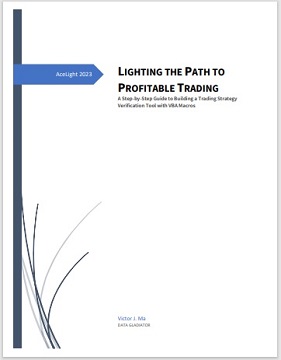Most Searched Stock Trading Strategies University Paper PDF
|
|
Do you think that researching how to trade stocks is only the job of
businessmen? No, many scholars in universities are studying and researching
this subject too. Hundreds of students, scholars, teachers, fellows, and
even professors are writing tons of papers about stock trading strategies,
and we can read a lot of these stock trading strategy PDFs online.
Here we can see some of the most searched stock trading strategies PDFs online, for example:
"Evaluating Trading Strategies" by CAMPBELL R. HARVEY AND YAN LIU
https://people.duke.edu/~charvey/Research/Published_Papers/P116_Evaluating_trading_strategies.pdf
CAMPBELL R. HARVEY is a professor at Duke University in Durham, NC, and a
fellow at the National Bureau of Economic Research in Cambridge, MA.
YAN
LIU is an assistant professor at Texas A&M University in College Station,
TX.
The university paper pdf provides some new tools to evaluate
trading strategies. The paper points out that when many trading strategies
have been tried and tested, evaluation methods like Sharpe ratios and other
statistics may be overstated. The paper's methods are simple to implement
and allow for real-time evaluation of trading strategies.
The paper
pdf then goes on to discuss a specific trading strategy detailed. The
strategy appears to be consistently profitable and even does well during the
financial crisis. However, the paper suggests that simply looking at
profitability, consistency, and drawdowns is not sufficient to give a
trading strategy a passing grade.
To properly evaluate a trading
strategy, the paper recommends using the tools presented in their research,
which is detailed in the references cited. By utilizing these tools,
investment managers can better evaluate the potential risks and rewards of a
given trading strategy and make more informed decisions.
"Technical
Trading Strategies" By Kadida Ramadhani Shagilla Mashaushi
https://etheses.whiterose.ac.uk/696/1/uk_bl_ethos_431997.pdf
Submitted in
accordance with the requirements for the degree of Doctor of Philosophy
The University of Leeds
Leeds University Business School
This
paper explores the effectiveness of technical analysis in generating returns
in financial markets, specifically focusing on the risk premium view as an
explanation for excess trading rule returns. The author relies on
theoretical alternatives to the efficient market hypothesis to examine the
possibility of market inefficiencies. Empirical analyses are conducted using
stock data from the London Stock Exchange and three US markets, as well as
data from ten small emerging markets in Africa. The analysis examines
whether differences in risk levels among various markets or market segments
can explain excess trading rule profits as compensation for bearing risk.
The results suggest that liquidity, book-to-market ratio, and institutional
arrangements can explain the excess profits from technical analysis. The
paper also discusses the appropriateness of certain risk estimates for
adjusting trading rule returns for risk. Overall, the paper contributes to
the literature on technical analysis and offers insights into the risk
involved in trading rule strategies.
Trading Strategies Introduction
http://web.stanford.edu/class/cs349f/slides/CS349F_lec10_trading_strategies.pdf
Stanford University
MOMENTUM TRADING STRATEGIES FOR INDUSTRY GROUPS:
A CLOSER LOOK
https://core.ac.uk/download/pdf/56366585.pdf
Constantine Hatzipanayis
B.Comm (Hons), University of Manitoba, 2000
RESERCH PROJECT SUBMllTED IN PARTIAL FULFILLMENT OF THE REQUIREMENTS FOR THE
DEGREE OF MASTER OF BUSINESS ADMINISTRATION
SIMON FRASER UNIVERSITY
This paper presents a study on intermediate-term momentum trading
strategies for industry groups, building upon previous research. The study
found that including more industries in the universe and purchasing/selling
fewer winning/losing industries in the strategy led to significantly more
profitable momentum trading strategies for industry groups. The winner and
loser portfolios were found to be made up of cyclical industries, and
industry momentum was observed to peak after a total time period of thirteen
to fourteen months, regardless of the number of industries examined.
Additionally, the returns to momentum trading strategies were found to vary
significantly throughout the year, with June and December being the most
significant months for momentum profits. The study also found that the
winner's momentum portfolio outperformed the market in 6 out of 9 bear
markets during the sample period, despite being perceived as riskier due to
industry concentration.
"An Exploration of Simple Optimized Technical
Trading Strategies" - Ben G. Charoenwong*
https://deepblue.lib.umich.edu/bitstream/handle/2027.42/91813/chben.pdf -
University of Michigan
This paper examines the performance and
statistical properties of three different trading strategies, specifically
focusing on their profitability and accuracy. The three strategies evaluated
are a filter strategy, moving average strategy, and arithmetic and harmonic
mean difference strategy, each utilizing different techniques for gathering
information. The paper investigates whether increased complexity of these
strategies leads to improved performance, as well as whether the strategies
are worth the computational cost. Using an out-of-sample evaluation for both
predictability and profitability, the study concludes that added complexity
does not necessarily lead to better performance, and simpler strategies can
be just as effective in terms of generating profits.
"Backtesting
Performance with a Simple Trading Strategy using Market Orders" - by Yuanda
Chen
https://www.math.fsu.edu/~ychen/research/backtesting.pdf - Florida
State University
This article pdf shows the backtesting result using LOB
data for INTC and MSFT traded on NASDAQ on 2012-06-21.
"Optimal
Strategies of High Frequency Traders" - by JIANGMIN XU
https://scholar.princeton.edu/sites/default/files/JiangminXu_JobMarketPaper_Revised_0.pdf
- Princeton University
This paper presents a model that explains the
behavior of high-frequency traders (HFTs) and the rationale behind their
pinging activities. Pinging refers to aggressive fleeting orders submitted
inside the bid-ask spread that are quickly cancelled. The model developed in
the paper suggests that HFTs use pinging to control inventory or chase
short-term price momentum without manipulative motives. The study uses
historical message data to reconstruct limit order books and characterizes
the optimal strategies of HFTs under the viscosity solution to the model.
The paper also gauges the implications of the model against data and
confirms that pinging is not necessarily manipulative but can be part of the
dynamic trading strategies of HFTs.
"Three Automated Stock-Trading
Agents: A Comparative Study" - by Alexander A. Sherstov and Peter Stone
https://web.cs.ucla.edu/~sherstov/pdf/amec04-plat.pdf - UCLA
The
University of Texas at Austin
Department of Computer Sciences
This
paper describes the development of three autonomous stock-trading agents
within the framework of the Penn Exchange Simulator (PXS). The PXS is a
stock-trading simulator that mixes agent bids with bids from the real stock
market. The three approaches presented in this paper take inspiration from
reinforcement learning, myopic trading using regression-based price
prediction, and market making. These approaches are fully implemented and
tested with results reported here, including individual evaluations using a
fixed opponent strategy and a comparative analysis of the strategies in a
joint simulation. The market-making strategy described in this paper was the
winner in the fall 2003 PLAT live competition and the runner-up in the
spring 2004 live competition, exhibiting consistent profitability. The paper
provides a detailed analysis of the market-making strategy's performance in
the live competitions.
"MATHEMATICAL MODELS IN FINANCE: TRADING
STRATEGIES" - by Paul Johnson
https://personalpages.manchester.ac.uk/staff/paul.johnson-2/resources/mathFinanceWorkshop/lecture-mfw.pdf
School of Mathematics
The University of Manchester
"Pairs Trading:
Performance of a Relative-Value Arbitrage Rule" - by Evan Gatev, Boston
College. William N. Goetzmann, Yale University. K. Geert Rouwenhorst, Yale
University
http://stat.wharton.upenn.edu/~steele/Courses/434/434Context/PairsTrading/PairsTradingGGR.pdf
- University of Pennsylvania
This paper examines the profitability of
a Wall Street investment strategy called "pairs trading" using daily data
from 1962 to 2002. The authors match stocks into pairs based on their
normalized historical prices and use a simple trading rule to generate
annualized excess returns of up to 11% for self-financing portfolios of
pairs. The authors find that these profits typically exceed conservative
transaction-cost estimates, and that the pairs effect differs from
previously documented reversal profits. The authors argue that pairs trading
profits from temporary mispricing of close substitutes and link the
profitability to the presence of a common factor in the returns, different
from conventional risk measures.
 Besides
those stock trading strategies PDFs listed above, we would also like to recommend our own tutorial
for your consideration: "LIGHTING
THE PATH TO PROFITABLE TRADING: A Step-by-Step Guide to Building a Trading
Strategy Verification Tool with VBA Macros" (It is not a university
paper, but the best part is that it is very easy to understand). No matter how good a stock trading strategy may
sound, it is important to verify it using scientific methods and tools. Even
with the same trading strategy, the results can vary greatly depending on
factors such as the target stock and parameter settings. Our tutorial
handbook provides ideas and tools for performing these verification tasks. Besides
those stock trading strategies PDFs listed above, we would also like to recommend our own tutorial
for your consideration: "LIGHTING
THE PATH TO PROFITABLE TRADING: A Step-by-Step Guide to Building a Trading
Strategy Verification Tool with VBA Macros" (It is not a university
paper, but the best part is that it is very easy to understand). No matter how good a stock trading strategy may
sound, it is important to verify it using scientific methods and tools. Even
with the same trading strategy, the results can vary greatly depending on
factors such as the target stock and parameter settings. Our tutorial
handbook provides ideas and tools for performing these verification tasks.
The guide is also helpful for
traders interested in testing various financial instruments, such as stocks,
Forex (foreign exchange), options, futures, cryptocurrencies, and bonds,
among others, using back-testing techniques. The handbook is available for
free download at this link, and we hope it provides traders with the
knowledge and skills they need to start building their back-testing
spreadsheet and testing their trading strategies.
And click Free Trial to download strategies testing tools, all for a 30-day Free Trial.
Click on Subscription to order more strategies testing tools to help your stock trading.
|


|

Free Tutorial
Share
|
|
|
|